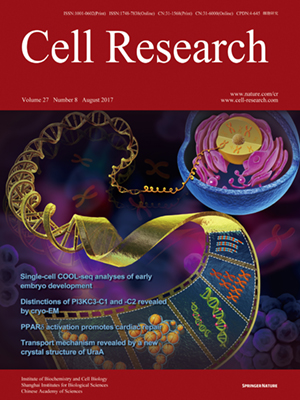
Volume 27, No 8, Aug 2017
ISSN: 1001-0602
EISSN: 1748-7838 2018
impact factor 17.848*
(Clarivate Analytics, 2019)
Volume 27 Issue 8, August 2017: 1065-1068 | Open Access
LETTERS TO THE EDITOR
Clonal analysis reveals remarkable functional heterogeneity during hematopoietic stem cell emergence
Hui Ye1,3,*, Xiaobo Wang1,*, Zongcheng Li1, Fan Zhou1, Xianlong Li4, Yanli Ni1, Weijing Zhang5, Fuchou Tang3,6,7,8, Bing Liu1,2,9 and Yu Lan1,2
1State Key Laboratory of Proteomics, Translational Medicine Center of Stem Cells, 307-Ivy Translational Medicine Center, Laboratory of Oncology, Affiliated Hospital, Academy of Military Medical Sciences, Beijing 100071, China
2Institute of Hematology, School of Medicine, Jinan University, Guangzhou 510632, China
3The Hospital of NO 61016 Troops of PLA, Beijing 102202, China
4Biodynamic Optical Imaging Center, College of Life Sciences, Peking University, Beijing 100871, China
5Affiliated Hospital, Academy of Military Medical Sciences, Beijing 100071, China
6Peking-Tsinghua Center for Life Sciences, Peking University, Beijing 100871, China
7Ministry of Education Key Laboratory of Cell Proliferation and Differentiation, Beijing 100871, China
8Center for Molecular and Translational Medicine (CMTM), Beijing 100101, China
9State Key Laboratory of Experimental Hematology, Institute of Hematology and Blood Diseases Hospital, Chinese Academy of Medical Sciences, Tianjin 300020, China
Correspondence: Bing Liu, Tel: +86-10-66947281 E-mail: bingliu17@yahoo.com; Yu Lan, Tel: +86-10-66947283(rainyblue_1999@126.com)
In conventional opinion, hematopoietic stem cells (HSCs) are alike, possessing robust self-renewal and multilineage differentiation capacity. However, growing evidence has revealed striking functional heterogeneity among individual HSCs, particularly in the aspect of lymphomyeloid output1,2,3. Four subtypes of HSCs with distinct differentiation patterns have been identified and designated as α-, β-, γ-, and δ-HSCs4.
10.1038/cr.2017.64
FULL TEXT | PDF
Browse 2330


